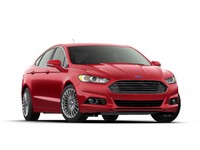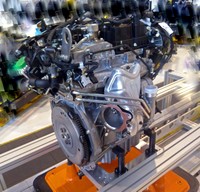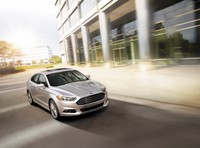Ford Infuses the Fusion with Start-Stop To Boost Fuel Economy

When it was redesigned for the model year 2014, the Ford Fusion struck an immediate cord with midsize sedan buyers thanks to its dashing good looks, quiet cabin, engaging road manners, excellent fuel economy and a long list of available techno gizmos that shames some luxury sedans.
Ford pushes the powertrain envelope by offering five engines, including three four-cylinder turbos from its EcoBoost engine family, a conventional iVCT (signifying intake variable cam timing, meaning more it’s efficient than its predecessors) plus a Atkinson-cycle engine augmented by an electric motor in the “traditional” gasoline-electric hybrid and the Fusion Energi, a plug-in hybrid. Hidden among those choices was an optional stop-start system called Auto Start-Stop for Fusion SE models equipped with the 1.5-liter EcoBoost four-cylinder engine and automatic transmission.
To clarify for the three Fusion models:
- The base S model offers a 2.5-liter four-cylinder and three EcoBoost options of 1.5, 1.6 and 2.0-liter displacements. Auto Start-Stop comes with the 1.5-liter and its 6-speed automatic transmission.
- The Hybrid and Energi models, which feature a 2.0-liter Atkinson-cycle engine and CVT transmission, also feature Auto Start-Stop, as do most hybrids.
Fusion’s Stop-Start System
The Fusion’s Auto Start-Stop falls under the “light stop-start” category. The system employs an enhanced starter (read beefed up), a more powerful 12-volt lead-acid absorbed glass matt (AGM) battery and an electrically driven transmission pump that maintains internal hydraulic pressure even with the engine off.
And, to minimize launch delays after engine restart, the transmission is kept in gear even with the engine off as opposed to shifting it into neutral.
The engineering challenge to automakers is to make stop-start systems transparent to the customers. The accessories have to continue working when the engine shuts off and the vehicle can’t jerk or stutter when the engine restarts.
To that end, Ford engineers developed unique algorithms for the brains of Auto Start-Stop – the computer programs that control it – and have filed more than 25 patents for engine and transmission control software functions.
For example, blending the voltage of the alternator and battery when the Fusion is slowing down helps to ensure the driver doesn’t experience any light dimming or sudden fluctuations in ventilation fan speed.
Also, sophisticated signal monitoring for the climate control system and the temperature of the evaporator core keep tabs on the interior. If the cabin temperature begins to rise on a hot day, the stop-start system will restart the engine while stopped to keep occupants cool.
Like most systems, the Fusion’s stop-start can be manually turned off.
Ford says its Auto Start-Stop improves fuel efficiency by about 3.5 percent overall while predominantly city drivers can save up to 10 percent. But, the improved fuel economy is not reflected in the government’s Environmental Protection Agency (EPA) estimated fuel economy ratings because their dictated test procedures don’t include much idling time. That will change with the upcoming 2017-25 fuel efficiency standards, which will give extra credit for “off-cycle” stop-start systems.
For now, the 2014 Ford Fusion SE with Auto Start-Stop will carry on with an EPA estimate of 23 mpg city/36 mpg highway and 28 mpg combined city/highway.
Under The Hood
Powering the Fusion SE with the stop-start option is a new 1.5-liter EcoBoost four-cylinder. Ford’s EcoBoost engines employ a turbocharger for an added jolt (boost) of power. They use direct fuel injection for optimal combustion, and have twin independent variable camshaft timing for intake and exhaust efficiencies that benefit fuel economy and power delivery.

Both of the smaller EcoBoost engines produce 178 horsepower, the 1.6-liter at 5,700 rpm, and the 1.5-liter at 6,000 rpm. Also different is torque: the 1.6’s rating is 184 pounds feet at 2,500 rpm while the 1.5-liter puts out 177 pounds feet at a much higher 4,500 rpm. This could result in a slightly increased 0 to 60 mph time from the 1.6-liter’s 8.2 seconds.
Zero to 60 mph time is an indicator of a vehicle’s ability to adequately merge onto freeways and pass on two-lane highways. The expected additional two or three tenths of second to 60 mph shouldn’t be noticed with the 1.5-liter engine.
Regardless of which engine powers the car, a 6-speed automatic transmission (or 6-speed manual with the 1.5-liter without start-stop) directs the output to the front wheels.
Design Elements
Fusion is a looker. It follows Ford’s “Kinetic” global-design theme also evident in the Focus and Fiesta. It’s characterized by a wide lower front air dam and a distinctive Aston-Martin-style trapezoidal grille flanked by headlights that sweep gracefully into muscular front fenders.
The long, low symmetries and raked rear window add a touch of sophistication. These attributes also contribute to the Fusion’s 0.27 coefficient of drag, a number once reserved only for concept cars.
From the driver’s seat, the surroundings are pleasant with a cabin design that is quite sporty for a mainstream sedan. Instrumentation is appealing, and white numbers on a black background are easy to read. Small screens on either side of the speedometer can display all kinds of information by manipulating buttons on the steering wheel, including navigation if so equipped.

Front occupants will find excellent head-, shoulder- and legroom along with seats that offer very satisfactory support. In back, where three adults is a crowd, headroom is adequate, but legroom is squeezed.
The Fusion SE is very well equipped with standard features that include keyless entry, a tilt/telescoping steering wheel, eight-way power driver’s seat, air-conditioning, and cruise control. Also included is Ford’s voice-activated Sync audio and cell phone interface and a six-speaker audio system with a CD player, auxiliary jack and a USB port/iPod interface.
Fusion is the feature-laden midsize sedan with options like self-parking, self-correcting lane assist and Blind Spot Information System (BLIS) with cross-traffic alert. It warns of traffic in a driver’s over-the shoulder blind spot, or oncoming traffic when backing from a driveway or parking space.
Also available is the MyFord Touch system that allows pairing a smart phone with voice recognition and optional navigation features displayed on its screen.
New options for 2014 include heated and cooled front seats and inflatable rear safety belts.
Pricing
The 2014 Fusion SE has a starting price of $23,935 plus a $825 destination charge. But that’s equipped with the naturally aspirated 2.5-liter four-cylinder engine with an EPA estimate of 22/34/26 mpg.
The stop-start system is only available with the 1.5-liter EcoBoost engine, which is a $795 option. Then, the Auto Start-Stop feature adds $295 for a total sticker price of $25,850.
If you’ve opted to purchase a SE with the EcoBoost engine that ups fuel economy to 25/37/29 mpg, adding an additional $295 for stop-start to gain an additional 3 to 10 percent in fuel economy seems like a no brainer.
Please check out these related articles:
What Is Start-Stop in a Car?
My Top 10 High-MPG Cars From 2013 (includes Fusion Energi)
Ford Expands Energi Plug-in Lineup

0 thoughts on “Overview: 2014 Ford Fusion With Start-Stop”